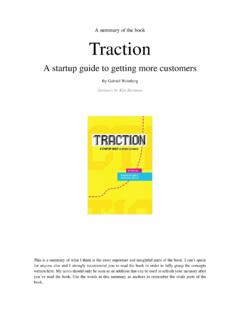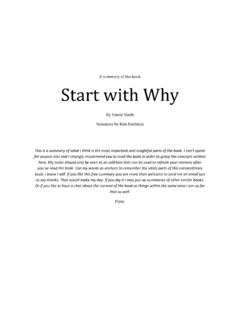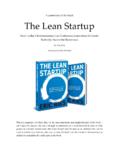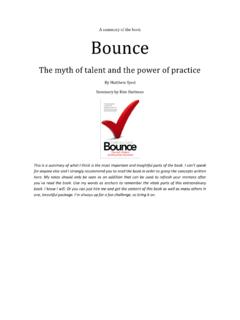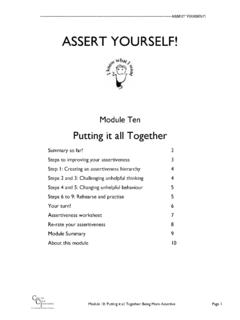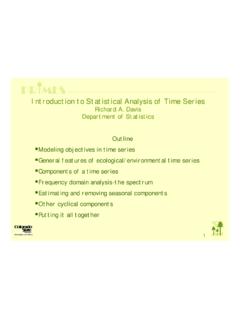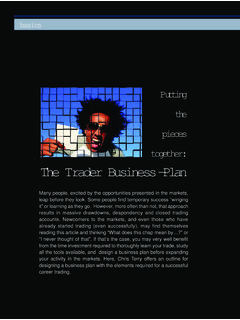Transcription of A whole new mind - Kim Hartman
1 A summary of the book a whole new mind Why right-brainers will rule the future By Daniel H. Pink Summary by Kim Hartman This is a summary of what I think is the most important and insightful parts of the book. I can t speak for anyone else and I strongly recommend you to read the book in order to fully grasp the concepts written here. My notes should only be seen as an addition that can be used to refresh your memory after you ve read the book. Use the words in this summary as anchors to remember the vitals parts of the book. More book summaries at Contact me at 1 Contents Description from amazon .. 2 The Conceptual Age .. 3 Chapter 1: Right brain rising .. 3 Chapter 2: Abundance, Asia, and Automation .. 4 Chapter 3: High concept, high touch .. 5 The six senses .. 6 Chapter 4: Design .. 7 Chapter 5: Story .. 8 Chapter 6: Symphony .. 9 Chapter 7: Empathy.
2 11 Chapter 8: Play .. 12 Chapter 9: Meaning .. 13 Previous book summaries .. 14 More book summaries at Contact me at 2 Description from amazon The future belongs to a different kind of person with a different kind of mind : artists, inventors, storytellers-creative and holistic "right-brain" thinkers whose abilities mark the fault line between who gets ahead and who doesn't. Drawing on research from around the world, Pink (author of To Sell Is Human: The Surprising Truth About Motivating Others) outlines the six fundamentally human abilities that are absolute essentials for professional success and personal fulfillment--and reveals how to master them. a whole new mind takes readers to a daring new place, and a provocative and necessary new way of thinking about a future that's already here. More book summaries at Contact me at 3 The Conceptual Age Chapter 1: Right brain rising The right hemisphere is specialized for synthesis; it is particularly good at putting isolated elements together to perceive things as a whole .
3 Analysis and synthesis are perhaps the two most fundamental ways of interpreting information. You can break the whole into its components. Or you can weave the components into a whole . Both re essential to human reasoning but guided by different parts of the brain. The left can grasp details. But only the right hemisphere can see the big picture. The left handles logic, sequence, literalness, and analysis. The right takes care of synthesis, emotional expression, context, and the big context. L-directed thinking: is directed by left-brain attributes towards a left-brain result. R-directed thinking: directed by right-brain attributes towards a right-brain result. More book summaries at Contact me at 4 Chapter 2: Abundance, Asia, and Automation For most of history, our lives were defined by scarcity. Today, the defining feature of social, economic and cultural life in much of the world is abundance.
4 Abundance has made L-directed thinking less significant. The prosperity it has unleashed has places a premium on less rational, more R-directed sensibilities beauty, spirituality, emotion. In an age of abundance, appealing only to rational, logical and functional needs is woefully insufficient. Engineers must figure out how to get things to work. But if those who things are not also pleasing to the eye or compelling to the soul, few will buy them. There are too many other options. The paradox of prosperity is that while standards have risen steadily decade after decade, personal, family, and life satisfaction haven t budged. That s why more people liberated by prosperity but not fulfilled by it are resolving the paradox by searching for meaning. People everywhere have moved from focusing on the day-to-day text of their lives to the broader context. Abundance has freed literally hundreds of millions of people from the struggle for survival.
5 More book summaries at Contact me at 5 Chapter 3: High concept, high touch Act 1: the industrial age. Factories, mass production and efficiency Act 2: the information age. Information and knowledge Act 3: the conceptual age. The main characters now are the creator and the empathizer, whose distinctive ability is mastery or R-directed thinking. Within a profession, mastery of L-directed thinking matters relatively little. More important are qualities that are tougher to quantify, the very kinds of high-concept and high-touch abilities such as imagination, joyfulness, and social dexterity. The Rainbow Project: Have so far been twice as successful as the SAT in predicting how well students perform in college. David Wolfe: As people mature, their cognitive patterns become less abstract (left-brain) and more concrete (right-brain) which results in a sharpened sense of reality, increased capacity for emotion, and enhancement of their sense of connectedness.
6 In other words, as individual s age, they place greater emphasis in their own lives on qualities they might have neglected in the rush to build careers and raise families: purpose, intrinsic motivation and meaning. Meaning is the new money in this new era. More book summaries at Contact me at 6 The six senses There are 6 specific high-concept and high-touch aptitudes that have become essential in this new era The six senses: Design Story Symphony Empathy Play Meaning Not just function but also design. Today it is economically crucial and personally rewarding to create something that is also beautiful or emotionally engaging. Not just argument but also story. Data isn t enough. The essence of persuasion, communication and self-understanding has become the ability also to fashion a compelling narrative. Not just focus but also symphony. While the industrial society specialized in making a few things in large numbers, the conceptual age is about putting the pieces together Symphony.
7 Not analysis nut synthesis seeing the big picture, crossing boundaries, and being able to combine pieces into an arresting new whole . Not just logic but also empathy. In addition to logic you need to have an ability to understand what makes your fellow man tick, to forge relationships, and to care for others. Not just seriousness but also play. There are evidences of enormous health and professional benefits of laughter, lightheartedness, games and humor. Not just accumulation but also meaning. Materialism has freed people from day to day struggles to pursue more significant desires: purpose, transcendent, and spiritual fulfillment. The high-concept, high-touch abilities that no matter most are fundamentally human attributes. More book summaries at Contact me at 7 Chapter 4: Design Design, stripped to its essence, can be defined as the human nature to shape and make our environment in ways without precedent in nature, to serve our needs and give meaning to our lives.
8 Design is a classic whole -minded aptitude. It is a combination of utility and significance. A graphic designer must whip up a brochure that is easy to read. That s utility. Her brochure must also transmit ides or emotions that words themselves cannot convey. That s significance. Paola Antonelli: good design is a renaissance attitude that combines technology, cognitive science, human need, and beauty to produce something that the world didn t know it was missing, Today, decent quality and reasonable rice has become merely table stakes in the business game the entry ticket for being allowed into the marketplace. Once companies satisfy these requirements, they are left to compete less on functional or financial qualities and more on ineffable qualities such as whimsy, beauty and meaning. For every percent of sales invested in product design, a company s sales and profits rise by an average of 3-4% according to research.
9 BMS s Chris Bangle: we don t make cars, we makes moving works of art that express the drivers love of quality. The typical person uses a toaster at most 15 min per day. The remaining 1425 minutes of the day the toaster is on display. In other words, 1% of the toaster s time is devoted to utility, while 99% is devoted to significance. Why shouldn t it be beautiful? One of designs most potent effects is this very capacity to create new markets. The forces of automation, abundance and Asia turn goods and services into commodities so quickly that the only way to survive is to constantly developing new innovations, inventing new categories, and giving the world something it didn t know it was missing. Good design offers us a chance to bring pleasure, meaning and beauty tour lives. But most important, cultivating a design sensibility can make our mall planet a better place. To be a designer is to be an agent of change.
10 More book summaries at Contact me at 8 Chapter 5: Story Stories are easier to remember because in many ways, stories are how we remember. Narrative imagining story is the fundamental instrument for thought. Rational depends on it. It is our chief means of looking into the future, of predicting planning, explaining. Most of our experience, our knowledge and our thinking are organized as stories. When facts become so widely available and instantly accessible, each one becomes less valuable. What begins to matter more is the ability to place these facts in context and to deliver them with emotional impact. The essence of story: context enriched by emotion. Story exists where high concept and high touch intersect. Story is high concept because it sharpens our understanding of one thing by showing it in the context of something else. Story is high touch because stories almost always pack an emotional punch.
